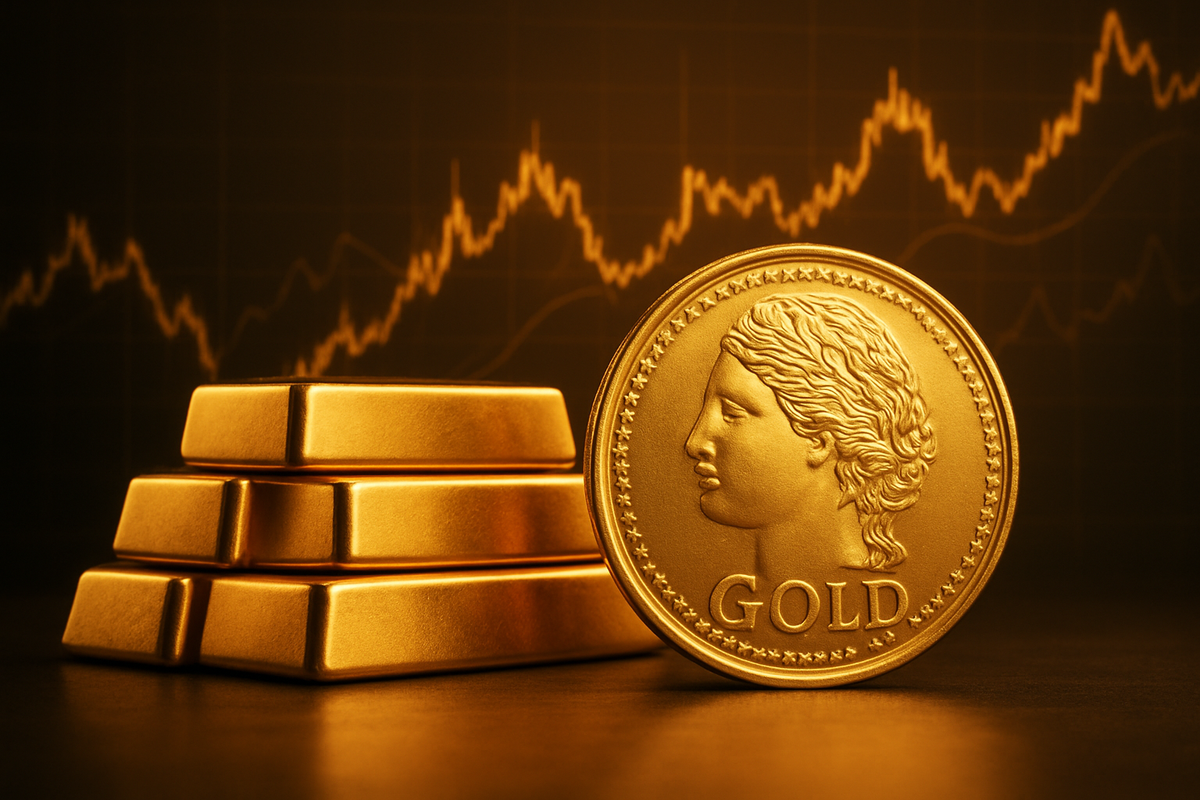
As November 2025 unfolds, investor sentiment towards gold stocks presents a fascinating paradox: a blend of cautious optimism and a steadfast conviction in the metal's long-term bullish trajectory, even as the market experiences short-term pullbacks. This nuanced outlook is deeply influenced by a complex interplay of persistent global economic and geopolitical uncertainties, coupled with evolving expectations around monetary policy. While gold prices had soared by over 50% throughout 2025, reaching unprecedented heights, a recent "healthy consolidation" in October has prompted a strategic re-evaluation, yet the underlying belief in gold's intrinsic value as a safe-haven asset remains robust.
The current environment suggests that while immediate volatility is expected, savvy investors are viewing these dips as strategic buying opportunities within a validated long-term bullish thesis. This period of adjustment is not seen as a fundamental reversal but rather a necessary recalibration after a significant rally, setting the stage for what many anticipate will be a continued upward trajectory for the precious metal and, by extension, for well-positioned gold mining companies.
Navigating the Golden Currents: A Detailed Look at Market Dynamics
The recent market dynamics for gold have been nothing short of remarkable. Following an impressive surge of over 50% throughout 2025, which saw gold prices breach the $4,000 per ounce mark and even touch an all-time high of $4,381.58 in October, the market experienced a notable, albeit short-lived, pullback. This October 2025 correction, characterized by profit-taking, has been largely interpreted by analysts as a "healthy consolidation" rather than a fundamental shift in the metal's structural bull market. Gold has since maintained significant year-to-date gains, holding firmly above the $4,000 per ounce level.
Several powerful drivers underpin this resilient investor confidence. Geopolitical tensions, ranging from the ongoing Ukraine war and Middle East unrest to US-China trade disputes, have consistently amplified gold's appeal as a safe-haven asset. Simultaneously, persistent global inflationary pressures and concerns over the long-term purchasing power of fiat currencies have reinforced gold's role as a vital hedge. A significant factor has been the insatiable demand from central banks worldwide, particularly in emerging markets like China, which are aggressively accumulating gold to diversify reserves away from the U.S. dollar. This strategic de-dollarization acts as a substantial and consistent demand driver, with central banks projected to purchase around 900 tonnes in 2025, following a record 1,082 metric tons in 2024. Furthermore, increasing investment flows into gold-backed Exchange-Traded Funds (ETFs) and strong institutional interest underscore a broader shift towards gold as a primary investment vehicle.
However, the path forward is not without its nuances. Diminishing expectations for aggressive interest rate cuts by the Federal Reserve and a stronger US dollar have recently tempered gold's upward momentum. Higher-for-longer interest rates increase the opportunity cost of holding non-yielding assets like gold, potentially leading to continued volatility. Initial market reactions have included a strategic reassessment by investors, a heightened focus on fundamentally strong gold miners, and ongoing challenges for junior mining companies in securing financing. Despite these headwinds, the overarching sentiment remains one of underlying bullishness, with many long-term investors viewing current dips as opportune moments for accumulation.
Who Wins and Who Loses: The Corporate Landscape of Gold
The current gold market environment creates distinct winners and presents ongoing challenges for others within the mining sector. Major gold mining companies, characterized by robust financial health, strong cash positions, and disciplined capital allocation strategies, are particularly well-positioned to capitalize on elevated gold prices. These companies have largely transitioned from debt-heavy balance sheets to robust cash positions, enabling them to generate significant free cash flow and return value to shareholders through dividends and share buyback programs.
Leading the charge are industry giants such as Newmont Corporation (NYSE: NEM, ASX: NEM, TSX: NEM, PNGX: NEM), the world's largest gold producer, which reported record free cash flow and authorized an additional $3 billion share repurchase program in Q2 2025. Similarly, Barrick Gold Corporation (NYSE: GOLD, TSX: ABX) demonstrated a strong financial position with liquid assets exceeding short-term obligations and authorized a new $1 billion share repurchase program. Agnico Eagle Mines Limited (NYSE: AEM, TSX: AEM) reported record financial results, moved to a significant net cash position, and renewed its share buyback program with an increased limit of up to $1 billion. Other strong performers include Kinross Gold Corporation (NYSE: KGC, TSX: K), which has been actively strengthening its balance sheet and reactivating its share buyback program, and Alamos Gold Inc. (NYSE: AGI, TSX: AGI), boasting strong free cash flow and a healthy cash position. Eldorado Gold Corporation (NYSE: EGO, TSX: ELD) also reported increased cash and active share repurchases, while AngloGold Ashanti plc (NYSE: AU, JNB: ANG) continues to be a major global producer focused on operational efficiency. These companies benefit immensely from the "multiplier effect" of high gold prices, where largely fixed operating costs mean higher gold revenues translate directly into increased profit margins and cash flow.
Conversely, junior gold mining companies often face persistent challenges in securing financing, despite an overall improvement in the junior mining sector's funding in 2025 compared to 2024. These companies are typically focused on exploration and development rather than revenue-generating production, making them inherently high-risk. Their success hinges on proving economically viable deposits, a feat achieved by only a fraction of exploration sites. An example illustrating these challenges is i-80 Gold Corp. (NYSE American: IAUX), whose shares slipped between late 2024 and late 2025 due to ongoing operating losses and dilution from equity raises aimed at funding ambitious development projects. While the broader trend for junior mining financings has shown some positive shifts, the sector remains characterized by "binary outcomes," meaning many individual junior companies will continue to struggle with capital constraints.
Broader Ripples: Gold's Impact on the Financial Ecosystem
The current investor outlook on gold stocks is not an isolated phenomenon but is deeply interwoven with broader industry trends and carries significant ripple effects across the financial ecosystem. Gold's role is evolving beyond just a safe-haven; it is increasingly viewed as a strategic asset for portfolio diversification and a critical hedge against systemic risks, ballooning deficits, and policy shocks in an ever-volatile global economic landscape. This perception is further bolstered by de-dollarization trends, where non-U.S. central banks are actively diversifying their reserves away from the U.S. dollar, cementing gold's structural demand. Interestingly, gold's strong performance stands in contrast to other commodities like nickel and zinc, which are struggling, indicating a divergence in the broader commodity cycle.
The enhanced profitability of major gold miners fuels investment in exploration and development, creating a positive ripple for suppliers of mining equipment and technology, especially those offering solutions for environmental compliance and operational efficiency. Financial services, including investment banks and gold-backed ETFs, experience heightened activity and inflows as demand for gold investment vehicles surges. Moreover, streaming and royalty companies, such as Franco-Nevada Corporation (NYSE: FNV, TSX: FNV), are particularly well-positioned, benefiting directly from rising gold prices without bearing the full operational risks and capital costs of traditional mining.
Regulatory and policy implications are also significant. The gold mining sector faces increasingly stringent environmental regulations in 2025, with mandates for emission reduction, water management, and land reclamation becoming standard. Maintaining a "social license to operate" through enhanced transparency and community engagement is now critical for long-term viability. While some regions, like the U.S., may see expedited permitting for mining projects to secure domestic mineral supplies, others, particularly in Africa and South America, are implementing tighter fiscal regimes or controversial legislation to maximize state revenues from mining, raising concerns about resource nationalism and environmental impact. Central bank gold purchases, a deliberate policy choice, signify a structural shift in global monetary policy, reflecting a desire to diversify away from the U.S. dollar.
Historically, gold has consistently proven its safe-haven status during periods of geopolitical instability and economic uncertainty, as seen during the 2008 Financial Crisis, the Dot-Com Bubble, and the COVID-19 pandemic. It has also served as a hedge against inflation, notably outperforming inflation over the past two decades. While gold and the U.S. dollar traditionally have an inverse relationship, the 2023-2025 period has occasionally seen both assets surge simultaneously, driven by amplified safe-haven demand. The current "buy on the dips" mentality among investors echoes historical precedents of strong post-crisis rebounds, suggesting an expectation of continued long-term upward momentum despite short-term pullbacks.
The Road Ahead: Navigating Gold's Future Landscape
Looking ahead, the gold market and gold stocks are poised for continued dynamism, with a strong long-term bullish outlook tempered by potential short-term volatility. In the immediate future (next 6-12 months), while gold prices are projected to rise towards $4,400 - $4,500 by the end of 2025, there's also a possibility of consolidation or even a pullback towards key support levels, potentially influenced by a stronger US dollar, profit-taking, or hawkish signals from the Federal Reserve. Investors should brace for ongoing volatility driven by evolving economic data and central bank communications.
For the long term (beyond 2026), the outlook remains predominantly bullish. Consensus forecasts for gold prices generally cluster around the $4,000 - $5,000 range for 2026, with some highly optimistic projections reaching as high as $6,000 by spring 2026 and $8,900 by 2030, assuming current inflation and uncertainty trends persist. This sustained rally will be fueled by continued central bank accumulation, persistent geopolitical instability, expectations of further interest rate cuts by the Federal Reserve, and ongoing inflation concerns. For gold stocks, this implies significant benefits, with expanding margins and robust profit growth for companies with low "All-In Sustaining Costs" (AISC).
Strategic pivots for investors include maintaining a core allocation to gold (e.g., 5-10% of a portfolio) as a hedge, exploring opportunities in well-capitalized gold mining equities for leveraged exposure, and considering diversification within the broader precious metals sector. Tactical trading, involving profit-taking during overbought conditions and accumulating during pullbacks, could also be beneficial. Crucially, investors must closely monitor macroeconomic signals, especially central bank monetary policies, inflation data, and the strength of the US dollar.
Market opportunities include the structural demand from central banks, monetary policy tailwinds (dovish central bank pivots), a persistent geopolitical risk premium, and de-dollarization trends. Challenges, however, include the potential for a stronger US dollar, a hawkish central bank pivot, a significant resolution of geopolitical conflicts (reducing safe-haven demand), and declining inflation expectations. For mining companies, rising production costs and increased regulatory scrutiny remain key challenges. Potential scenarios range from a bullish "Gold Rush" where prices soar to new record highs, leading to substantial returns for strategic investors, to a moderate growth scenario with periodic sharp corrections, requiring agile navigation. A less likely but possible bearish correction scenario could see prices fall significantly due to a combination of sustained dollar strength and a hawkish Fed.
The Golden Horizon: A Comprehensive Wrap-Up
In summary, the investor outlook on gold stocks in November 2025 is characterized by a compelling narrative of cautious optimism, underpinned by an enduring belief in gold's role as a fundamental store of value and a hedge against global uncertainties. Despite recent short-term pullbacks, which are largely viewed as healthy consolidations, the market is structurally bullish, driven by persistent geopolitical tensions, inflationary pressures, and unprecedented central bank demand. Major gold mining companies with strong financials are poised to benefit significantly, while junior miners continue to face financing hurdles.
Moving forward, the gold market is expected to remain dynamic, with continued volatility in the short term but a strong upward trajectory anticipated over the long haul. The wider significance of these trends extends to broader industry shifts, impacting other precious metals, mining suppliers, and financial institutions, while also being shaped by evolving regulatory landscapes and central bank policies.
Investors should closely watch key indicators such as central bank communications, global inflation data, geopolitical developments, and the performance of major gold miners. The current environment presents both opportunities for long-term accumulation, particularly during dips, and challenges that necessitate careful portfolio management and a focus on fundamentally sound investments. Gold's enduring appeal as a safe haven and a strategic asset ensures its continued prominence in investment portfolios, making it a critical component to watch in the coming months and years.
This content is intended for informational purposes only and is not financial advice






